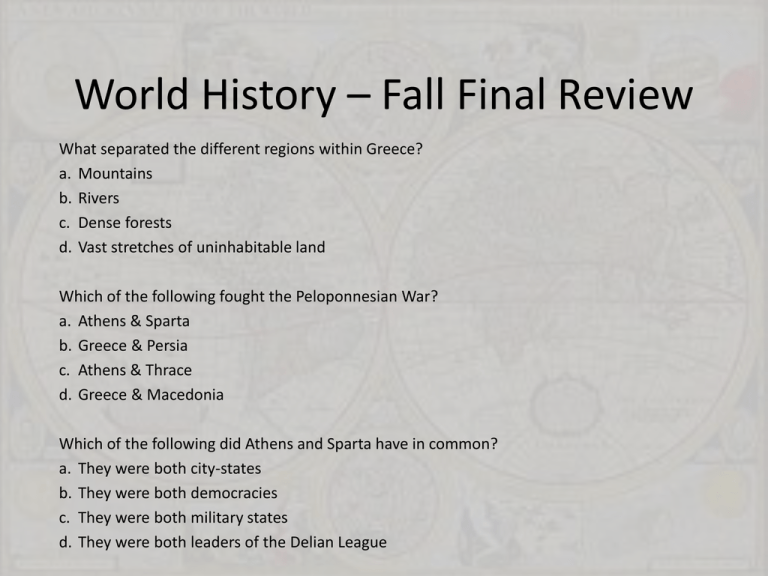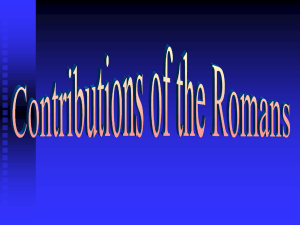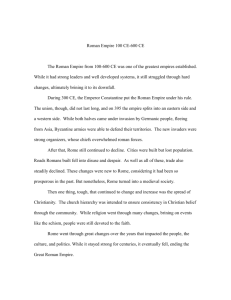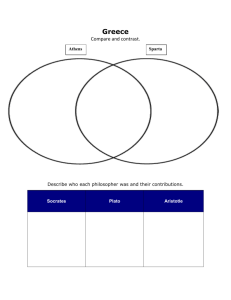World History * Fall Final Review
advertisement

World History – Fall Final Review What separated the different regions within Greece? a. Mountains b. Rivers c. Dense forests d. Vast stretches of uninhabitable land Which of the following fought the Peloponnesian War? a. Athens & Sparta b. Greece & Persia c. Athens & Thrace d. Greece & Macedonia Which of the following did Athens and Sparta have in common? a. They were both city-states b. They were both democracies c. They were both military states d. They were both leaders of the Delian League A phalanx was a type of a. Mythical creature b. Military formation c. Governmental body d. Military conquest Which philosopher was condemned to death for "corrupting the youth of Athens" and "neglecting the city's gods"? a. Plato b. Aristotle c. Socrates d. Protagoras Who wrote The Republic, a book that set forth his vision of a perfectly governed society? a. Plato b. Pericles c. Socrates d. Sophocles The major power struggles in the early Roman republic were between ___. a. Military and civilians b. Citizens of Rome and citizens of the provinces c. Members of the aristocracy and common citizens d. The executive and legislative branches of government Roman rulers opposed Christianity because Christians ___. a. were mostly Jews. b. called for the overthrow of Roman rulers. c. ignored wealth and status. d. would not worship Roman gods. As a result of 207 years of Pax Romana, the Roman Empire ___. a. experienced continuing hostilities among neighboring regions. b. survived invasions from barbarian tribes. c. shrank in size and wealth. d. experienced peace and prosperity. The Jewish Diaspora refers to ___. a. the destruction of the Temple in A.D. 70. b. the years the Jews were slaves in Egypt. c. Jerusalem. d. the forced dispersal of Jews. In the early Roman government, who were the consuls? a. the chief executives of the government b. the representatives of the common citizens c. citizens of Rome and citizens of the provinces d. the executive and legislative branches of government What conflict of interests lay between Rome and Carthage? a. control of Egypt b. control of the Mediterranean Sea c. control of Anatolia d. all of the above What were the reasons that Christianity spread throughout the Roman Empire? a. It embraced all people: men and women, rich and poor. b. Rome's excellent roads encouraged the exchange of ideas. c. Jesus promised eternal life. d. All of the above are true. Which was an important part of the Roman economy? a. trade b. slavery c. agriculture d. all of the above Which of the following groups of terms best summarizes the legacy of the Roman Empire? a. philosophy, drama, architecture, religion b. technology, law, philosophy, poetry c. architecture, engineering, law, language d. language, drama, art, religion According to the code of chivalry, a knight fought for all of the following EXCEPT a. his lady. b. his country. c. his feudal lord. d. his heavenly Lord. The interdict was an effective weapon for a pope to use against a king because a. it would deprive the king of his own personal salvation. b. it gave other rulers permission to war against the offending king. c. it decreed that the king must give up his kingdom and leave Europe forever. d. it cost the king the loyalty of his subjects, who feared for their own souls. Why did learning decline during the last years of Roman Empire? a. Invaders burned most of the empire's collections of manuscripts. b. Invaders could neither read nor write and did not understand Latin. c. Everything written in Greek was destroyed by the invaders. d. All of the above are true. What were the forces holding feudal society together? a. a set of mutual social obligations and the teachings of the Church. b. loyalty to country and belief in God c. pride in their Roman heritage and a thriving economic system d. The code of chivalry, the laws of Rome, and the teachings of the Church Canon law deals with issues under the authority of a. the Church. b. the military. c. the emperor. d. a feudal lord. What was the chief goal of the Crusades? a. to spread Christianity throughout Europe, Asia, and Africa b. to recover Jerusalem and the Holy Land from the Muslim Turks c. to improve trade among Europe, Asia, and Africa d. to force the Byzantines to become Catholics What was the effect of the three-field system? a. Farmers produced more food and villagers had more to eat. b. Farmers could grow crops on one-half of their land. c. Farmer could let their ground lie fallow over the winter. d. Farmers could grow crops on one-third of their land. What did the Magna Carta guarantee? a. the end of taxation b. a model parliament c. basic legal rights d. a House of Commons What did the decisions of the English royal courts of justice create? a. the code of chivalry b. the Estates General c. the Model Parliament d. English common law How did the Battle of Hastings change the course of English history? a. The Anglo-Saxons took control of England. b. The Normans took control of England. c. English became the dominant language. d. The Danish Vikings were driven out of England. What was the Renaissance a rebirth of? a. Christian devotion b. art and learning c. chivalry and tournaments d. good health after the plague What was the first full-sized book Gutenberg printed? a. Utopia b. Romeo and Juliet c. the Bible d. The Prince In what way did Leonardo da Vinci represent the Renaissance Man? a. He was a painter, sculptor, inventor, and scientist. b. He painted the Mona Lisa while holding scientific discussions. c. He lived in Italy during the 1500s. d. He used perspective in all of his drawings and paintings. What kind of person represented the ideal of the "Renaissance man"? a. someone who enjoyed worldly pleasures b. someone who excelled in many areas of study c. someone who specialized in a particular field of study d. someone who supported and appreciated the arts without creating art What were Desiderius Erasmus and Thomas More? a. German painters b. Flemish painters c. patrons of the arts d. Christian humanists Which of the following was one of Luther's main beliefs? a. Men and women are naturally sinful. b. Christians needed to be baptized again as adults. c. Good works were required for salvation. d. All people with faith were equal. A person who produces work "in the vernacular" is one who a. relies on realism. b. uses only natural light. c. uses a verse form of writing. d. writes in a local, rather than a classical, language. The printing press was invented by a. Jan van Eyck. b. Johann Gutenberg. c. Peter Bruegel the Elder. d. Hans Holbein the Younger. Who made this drawing? a. Leonardo da Vinci b. Michaelangelo c. Raphael d. Leonardo da Vinci Who painted The Last Supper? a. Michaelangelo b. Leonardo da Vinci c. Raphael d. Donatello This painting is called The School of Athens. The Renaissance painter who painted this was a. b. c. d. Leonardo da Vinci Michaelangelo Raphael Donatello Mona Lisa was painted by a. Mr. Lisa b. Lorenzo de Medici c. Leonardo da Vinci d. Michaelangelo This artwork is located on the ceiling of the Sistine Chapel. Who was the painter? a. Leondardo da Vinci b. Michaelangelo c. Raphael d. Donatello What caused the major difficulties in uniting ancient Greeks under a single government? a. the size of the region b. the geography of the region c. The independent nature of the people d. All of the above This scientist arrived at a fairly accurate calculation of the value of pi (?). Archimedes This astronomer arrived at a surprisingly accurate calculation of the earth's circumference. Eratosthenes This astronomer argued that the sun was much larger than the earth and that the planets revolve around the sun. Aristarchus This mathematician's work is still the basis of courses in geometry. His best-known work was the textbook, Elements. Euclid ___ was NOT a reason for the decline of the Roman Empire. a. A strong military b. The huge amount of money spent on defense, coupled with inflation c. The invasions by Germanic tribes and by Huns d. The disruption of trade







